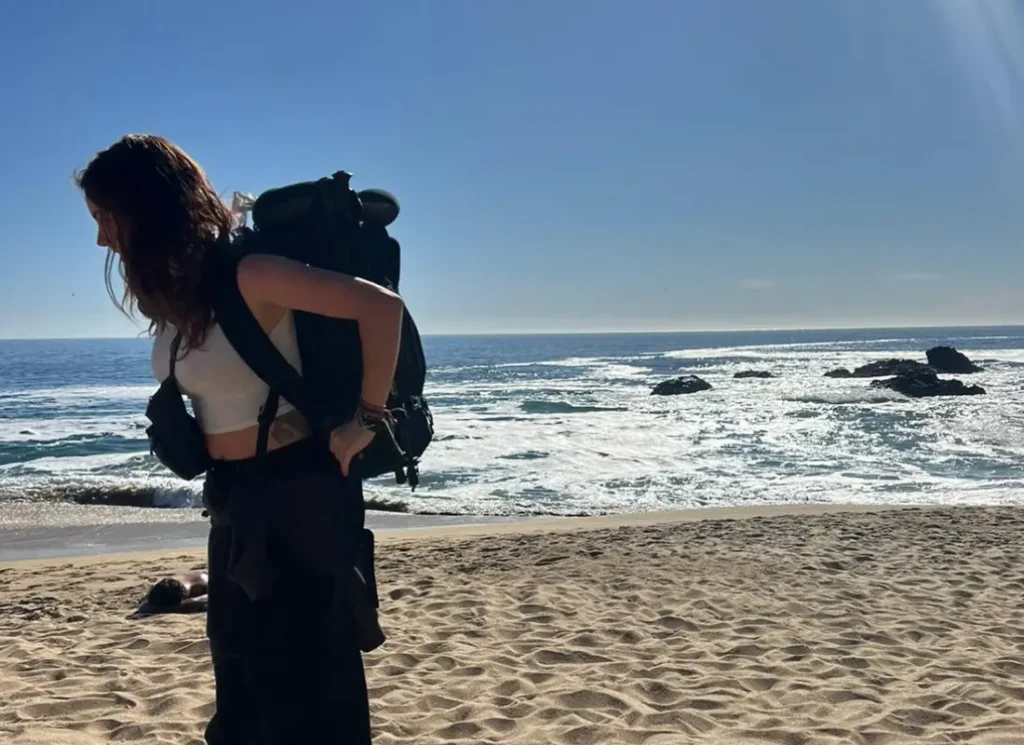I have a lot to say about backpacks. I’ve done my fair share of backpacking, and I think I’ve taken a different bag on every single trip. For me, a backpack is one of those things that needs to be “just right” and, well, I still don’t think I’ve found the right backpack for me.
What I do know, however, is exactly what to look for in a backpack, and the components I want my perfect backpack to have. I just haven’t seen every single one of those things all in the same backpack… yet. If you’re in a hurry and don’t want to hear it all broken down, skip straight to my top picks to see which backpacks I’ll be considering for my next trip!
By far the most important thing when choosing the best travel backpack for you is that it is comfortable, but that means something different to everybody. I’ll break it down later in the article, but when you’re thinking about comfort you need to think about: Does this backpack feel nice when I’m wearing it? How easy is this backpack to get on and off? Can I access everything I need easily without taking it off?
Even for a short walk from the bus station to your hostel, you’re going to notice quickly if your backpack is uncomfortable.
When I was backpacking in Costa Rica this January, my backpack broke. This was largely my fault – I set off on this four month trip with an old backpack (and old shoes, but that’s a story for another day). I took a 30L backpack and a small yellow tote, which in hindsight was a bit optimistic, space-wise. Yes, everything fit, but just barely, and I hadn’t accounted for the fact that I might actually want to buy stuff.
I had just spent two weeks travelling with my friend, Ellie, and she had one of these backpacks that opens like a suitcase. I was obsessed. It took me about three times as long to pack my bag as it did her, so I was absolutely sure that I needed one just the same.
I was spending time with a Costa Rican boy in San Jose who recommended to me the company La Fiebre de Viajar. He really, really wanted one of their backpacks so after much umming and arring, I decided to order one, too.
It’s true that the suitcase thing was great. I LOVED having a backpack that opened like a suitcase and I really will never go back to a top loader again. However, the rest of the backpack was kind of rubbish. (I keep saying that I’ll do a full review later. And I will, I promise!)
Anyway, here’s everything to consider when you’re choosing a backpack for travelling.
Types of Straps
Shoulder Straps
Of course, you know that a backpack has shoulder straps, but have you ever stopped to consider how important they are? If you’ve ever gone a long way with a backpack with thin straps, you’ll know what I’m talking about. You want thick, sturdy, ergonomic straps that don’t dig into your skin. This is much more important than you think it will be, not just for the way it digs into your skin, but the direction they pull on your shoulders too!
Compression Straps
Compression straps are the straps that hold the bag together, and can make it fit into slightly smaller spaces. They can also help to distribute the weight evenly if your bag isn’t completely full (which it shouldn’t be at the start of your trip – a lesson I learned the hard way!).
Hip Belt
The hip belt is an absolute essential if you’re planning on actually going anywhere with your rucksack. I can guarantee for you now that, no matter how well you think you planned your trip, you will have some long and unexpected walks to do between hostels, to and from the bus station, or even just through the airport.
The hip belt is designed to put the weight of the backpack onto your hips instead of your shoulders, and is really, really important. I know talking about avoiding a bad back makes me sound really old, but if you take care of your body then it will take care of you.
Sternum Strap
The sternum strap is one that goes across your chest, and again is designed to take pressure off your shoulders. If you’re a person with boobs, make sure your chest straps are adjustable so you can move it to sit either above them or below them, to your preference. (The sternum straps that don’t move are usually designed for men and fully just squish your boobs, and that’s not a good look (or feel).)
Read more: What to Pack for Backpacking in Guatemala
Getting the Right Fit
Internal Frame
If you’re going away for any length of time, it’s important to get a backpack that has an internal frame (and this is one of many things that my La Fiebre de Viajar backpack was missing). It helps the backpack to fit to your body, distributes the weight to the right places, and generally gives it some structural integrity!
Sex / Body Type
You will notice that a lot of backpack companies, including Osprey and Decathlon, offer different versions of the same bag for men and women. Although you can literally see the sexism (why are the women’s bags always pink or bright turquoise?), this is actually a really important factor to consider.
This absolutely doesn’t mean that you can’t take a women’s bag if you’re a man or vice versa, but it’s important to think about your body, and what’s right for it.
Women’s bags tend to be slightly smaller, and curved to fit the average-woman’s body and hips. I can’t stress enough that this isn’t a one-size-fits-all, but there are physical differences between the two bags, so bear this in mind when you’re shopping.
For example, the La Fiebre de Viajar bag that I took on my trip from Costa Rica was unisex but had clearly been designed for men, because the shoulder straps wouldn’t tighten tightly enough on me, and I’m 167cm tall!
Organisation
Click here to skip to our packing and organisation section!
Travel Packs
So I said above that I will always be looking for front-loading backpacks from now on, and I’ll talk a little more about that below, but even with a front-loading backpack I used packing cubes. I got some for free with the backpack that I bought in Costa Rica and they were much better quality than the ones I was using. Packing cubes will change your life, and using good-quality ones even more so!
Main Compartment
When you’re backpacking, having easy access to all of your belongings is essential, as is easy packing. If you’re moving to a new hostel every few days, you’ll quickly get tired of it if you don’t have a bag that’s easy to pack.
Top loading backpacks were just standard a few years ago, but since front-loading backpacks (the ones that open like a suitcase) have started becoming more popular, I’m a true fan. Even more of the ones with in-built compartments, because they’re just so darned easy to organise!
External Pockets
External pockets are more of a necessity if you don’t have a second backpack (but if you hold on, I’ll tell you why I think you should have one!). You should at least be able to get quick access to your water bottle and valuable items, like your money, phone and passport.
Laptop Compartment
As a travel blogger, any backpack gets extra points from me for having a laptop sleeve! However, most people I’ve met on my travels don’t carry a laptop. I am foolish and I travel with my laptop loose, rather than inside a laptop sleeve, but I wouldn’t recommend it 😉
Read more: What to Pack for Backpacking in Costa Rica
Carry-on or Hold?
I would always, always recommend taking a carry-on travel backpack. If your backpack is big enough to need to go in the hold, it’s probably too big for you to carry, too.
Choosing The Size
Long-term Travel
For long-term travel (which for this purpose I’m classing as anything more than a month, just because I’d take the same amount of stuff if I was travelling for one month or ten), I’d recommend a bag of 40-60 litres. Anything bigger than 60 litres and it’s going to get heavy. Take into consideration if you’ll be carrying your bag for long distances and, of course, the length of your trip, but only take the essentials (yes, even on long trips!).
On my last trip I met a girl who was travelling for three weeks with a backpack that looked easily over 100 litres, with a second backpack that was probably bigger than my main one. I also met someone carrying a 20L bag for over a month. You will always see both extremes, but it’s best to fall somewhere in the middle…!
Short Trips
If you’re travelling for a matter of weeks rather than months, the right size of bag for me personally would be 30 to 40 litres. Of course, it depends on the number of activities that you want to do when you’re travelling, but taking a big bag is only going to hold you back!
Activities to Consider
Day Hikes
If you’re going to be going on a lot of day hikes or trips, make sure you take a good quality second backpack with you. Firstly, you won’t want to take a huge backpack on a hike anyway, but secondly you won’t have anywhere to store the stuff that you leave behind!
Bus Trips
If hiking is less your thing but you will be travelling by bus, then make sure to take an additional bag (but it doesn’t need to be a backpack) to take all of your valuables on-board the bus. Your larger bag will get stowed in the luggage compartment, and that is not where you want to leave anything of worth.
Waterproofing
Some bags are water resistant, some bags come with a rain cover. Some have both, some have neither. If you’re travelling somewhere in rainy season or you’re planning to do some travelling by boat, make sure it’s something you consider when choosing your backpack!
Read more: What to Pack for a 7 Day Trip
My Top Picks
All of the above considered, here are some of what are, in my opinion, the best backpacks on the market. These are all backpacks that I’ve seen other travellers using, but like I said, I’m not convinced that I’ve found or tried the perfect backpack (not yet, at least!). These are some of the bags I’ll be considering for my next trip.
Cotopaxi Allpa
I’ve had my eye on this backpack for a while because it’s small, lightweight, and is front loading. However, I did notice that the waist belt may not be the sturdiest and it doesn’t have a lot of external pockets.
Osprey Farpoint/Fairview
The Osprey Farpoint is designed for men, and the Osprey Fairview is designed for women. They come in a variety of sizes, which is of course just personal preference, but if you want to go for a bigger backpack then this is the one I’d recommend. They are really versatile with the number of ways you can carry them, and you can also buy two and strap them together.
Forclaz Travel Backpack
This is the bag that Ellie had when we were travelling in Guatemala and Nicaragua, and this one gets bonus points for not being hundreds of dollars. It front opens, and has a lot of compartments, too. The only thing I don’t like about it is that it’s more deep than wide, which means you get a lot of pull on your shoulders when you wear it.

